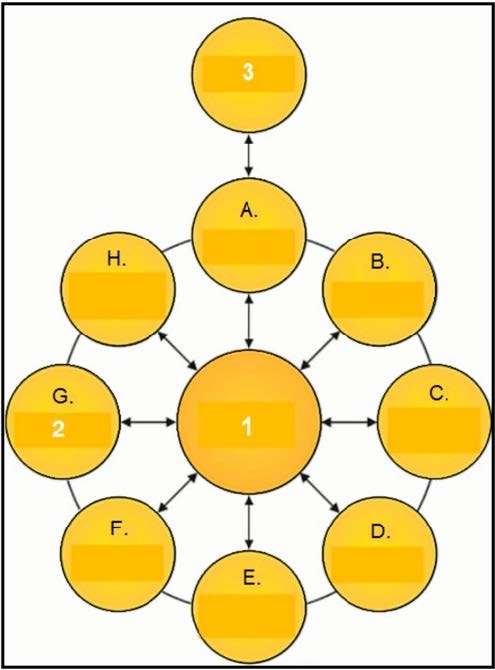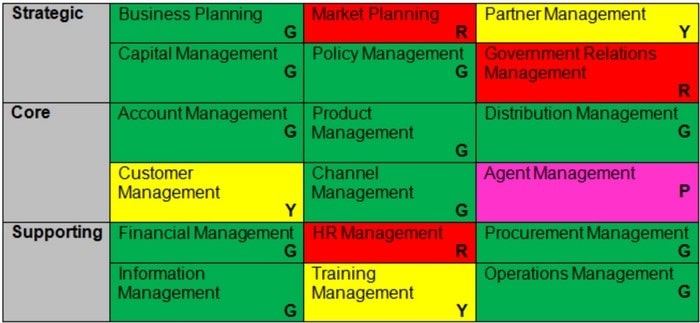OGBA-101 Online Practice Questions and Answers
Consider the diagram of an architecture development cycle.

Which description matches the phase of the ADM labeled as item 2?
A. Conducts Implementation planning for the architecture defined in previous phases
B. Provides architectural oversight for the implementation
C. Operates the process of managing architecture requirements
D. Establishes procedures for managing change to the new architecture
Which of the following is a benefit of developing a TOGAF business scenario?
A. It provides a versatile approach to business planning.
B. It can be an important aid to vendors in delivering appropriate solutions.
C. It provides an organizing framework for the change activity in a project.
D. It provides general rules and guidelines to support planning at the enterprise level.
Complete the sentence. A business model is a description of the rationale for how an organization creates, delivers, and captures............
A. strategy
B. business function
C. best practices
D. value
Consider the diagram of an architecture development cycle.

Select the correct phase names corresponding to the labels 1, 2 and 3?
A. 1 Architecture Governance - 2 Implementation Governance - 3 Preliminary
B. 1 Requirements Management - 2 Change Management - 3 Strategy
C. 1 Requirements Management - 2 Implementation Governance - 3 Preliminary
D. 1 Continuous Improvement - 2 Migration Planning - 3 Architecture Vision
Which of the following best describes a benefit of business models?
A. They provide a different viewpoint to cross-check assumptions.
B. They can be used to resolve conflicts amongst different stakeholders.
C. They can be used to calculate detailed cost estimates.
D. They highlight what the business does without the need to explain why.
In what TOGAF ADM phase should the architect locate existing architecture descriptions to create an information map?
A. Phase A
B. Preliminary Phase
C. Phase B
D. Phase E
Which of the following is a derived relationship in an organization map?
A. Value flow
B. Location
C. Capability
D. Scope of enterprise
Which of the following is a benefit of organization mapping?
A. An organization map can be reused for training and employee development.
B. An organization map highlights inefficiencies and reduces operational costs.
C. An organization map improves the ability to consume, process, and deliver information.
D. An organization map improves strategic planning.
Which of the following best describes where business scenarios are used in the TOGAF ADM?
A. They are used to resolve impacts across the Architecture Landscape in Phases B, C, and D.
B. They are used in the Preliminary Phase, Phase A, and Phase B.
C. They are used as part of the lessons learned activity at the end of Phase F.
D. They are used as part of a business transformation readiness assessment in Phase E.
Which approach to model, measure, and analyze business value is primarily concerned with identifying the participants involved in creating and delivering value?
A. Value chains
B. Value networks
C. Lean value streams
D. Value streams
Which of the following is the element of a value stream stage that describes the state change that triggers the value stream stage?
A. Baseline state
B. Enhance criteria
C. Starting point
D. Gating stage
Which of the following is guidance for creating value streams?
A. Identify the top-level value streams from components of capabilities.
B. Include operational levels of detail.
C. Start with customer-based value streams.
D. Create an initial set of value streams that map one-to-one to existing capabilities.
Where are business scenarios used most prominently in the TOGAF ADM?
A. They are used as part of a business transformation readiness assessment in Phase E.
B. They are used in the Phase A to discover and document business requirements.
C. They are used as part of the lessons learned activity at the end of Phase F.
D. They are used to resolve impacts across the Architecture Landscape in Phases B, C, and D.
Which statement best describes iteration and the ADM?
A. The ADM is sequential. Iteration is applied within phases.
B. The ADM is iterative, over the whole process, between phases, and within phases.
C. The level of detail is defined once and applies to all iterations.
D. The ADM is iterative between phases B to D, and between Phases E and F.
Consider the following business capability model, where cells of a model are given different colors to represent desired maturity levels (Green (G) = level achieved, yellow (Y) = one level away, red (R) =two more levels away, purple (P) = missing capability):

Which of the following best describes what this model shows?
A. Policy Management, Government Relations Management, and HR Management need immediate attention. Partner Management, Account Management, and Training Management have issues but are of lower priority. Agent Management is a new business capability that does not exist.
B. Market Planning, Government Relations Management, and HR Management need immediate attention. Partner Management, Customer Management, and Training Management have issues but are of lower priority. Agent Management is a new business capability that does not exist.
C. Customer Management, Training Management and Partner Management need immediate attention. Market Planning, HR Management and Government Relations Management need attention. Agent Management exists as a new Core capability but has not yet been assessed.
D. The Strategic capabilities need more attention in three areas, Market Planning, Government Relations Management, and Partner Management. Agent Management is missing as a Core capability. Training Management needs the most attention as a Supporting Capability.
